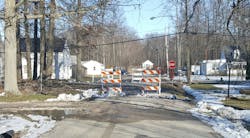Ohio fire department deploys barricades for emergency road closures
After a storm hit northeastern Ohio on March 1, 2018, an estimated 80,000 people lost electrical power as a result. High winds, gusting as strong as 50 mph, brought many power lines down, and numerous road closures were reported throughout the area. The storm, severe enough to earn its own name, Riley, subsequently tore through the mid-Atlantic and New England states on March 2-3, leaving more than 1.9 million people without power.
Efforts to restore power in northeastern Ohio were exacerbated by the high winds, and emergency crews could not deploy bucket trucks to repair the lines. Instead, as the local news reported, crews “had to do what’s called a ‘cut and run’, where downed lines would be severed before crews moved to the next location.” Crews would return to restore power when the winds had subsided.
In Ashtabula County, Geneva-on-the-Lake is located on the shores of Lake Erie, where, even on normal days, high winds are not uncommon. As a result of Storm Riley, the village suffered quite a few downed wires, brought down by the wind and falling trees. Those downed wires invariably came down on or adjacent to a road.
The village’s fire department is responsible for emergency road closures. Captain Andy Kaschalk, a firefighter and emergency medical technician (EMT), said, “Our job is to secure the area around the downed live wires as quickly as possible so emergency repair crews can work safely. Our goal is to secure the scene in 10 minutes or less, as we often have other calls to answer.”
As the village is a popular summer destination, the department has developed an expertise in traffic control and crowd control services. The department often deploys LaneGard 3 Folding Type III Barricades by PSS for such tasks.
Prior to its use of LaneGard to address the post-storm situation, the department closed roads with 28-in. traffic cones or emergency caution tape, but found them less than satisfactory. “Either it’s too windy, and the cones move around, or the tape blows away, or drivers drive over the cones or through the tape. We often found tape a couple blocks away from the road closure,” Captain Kaschalk said.
When fully assembled, LaneGard folds for transport, and is ready for immediate deployment. No need to assemble barricades from components at the site. The fire department transports LaneGard barricades in a brush truck, and can deploy a single LaneGard unit in about 30 seconds.
To close a road during last week's storm, two firefighters deployed four LaneGards in under 5 minutes. (See picture below.) They quickly secured the scene, and then were free to leave to respond to another call.
Captain Kaschalk appreciated the quick deployment, which freed up time for other, perhaps more critical, calls. With the barricades on the job, drivers complied with the emergency road closure.
According to Kaschalk, LaneGard also performed well during the storm. “We had rain, then ice, then snow, and 55-60 mph winds. Those winds moved the barricades a little, as we don’t use sandbags, but they didn’t blow over,” he said.
LaneGard is designed for use with PSS Wave centerboards. The configuration used by the Geneva-on-the-Lake Fire Department featured 4-ft Wave centerboards and weighed less than 30 lbs. Installers did not have to wrestle with heavier, multi-pieced, metal or wood barricades.
LaneGard meets MUTCD requirements for Type III Barricades, holds an FHWA-issued acceptance letter (WZ-336), and has met Test Level 3 standards of AASHTO’s “Manual for Assessing Safety Hardware” (MASH).
LaneGard 3 Folding Type III Barricades feature a one-piece design that folds for transport and storage, unfolds for quick deployment and use. A barricade measures only 2.562 in. wide when fully assembled in its folded position, and once assembled, it can remain assembled. Weighing only 17 lb without centerboards, the barricade can be unfolded by one person in a matter of mere seconds, thus closing a lane or road with several units in only minutes.
